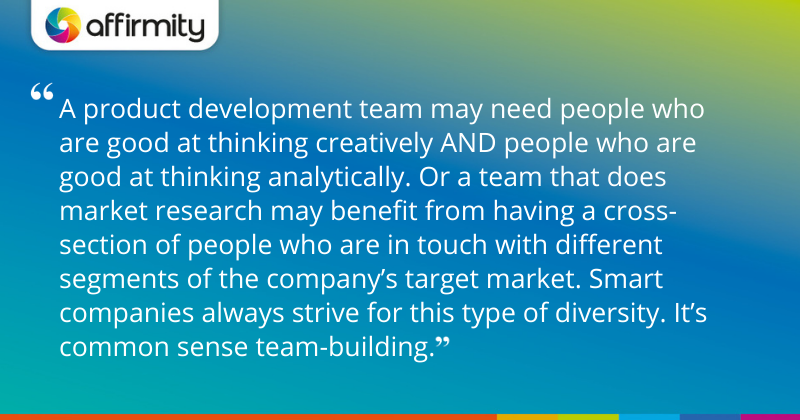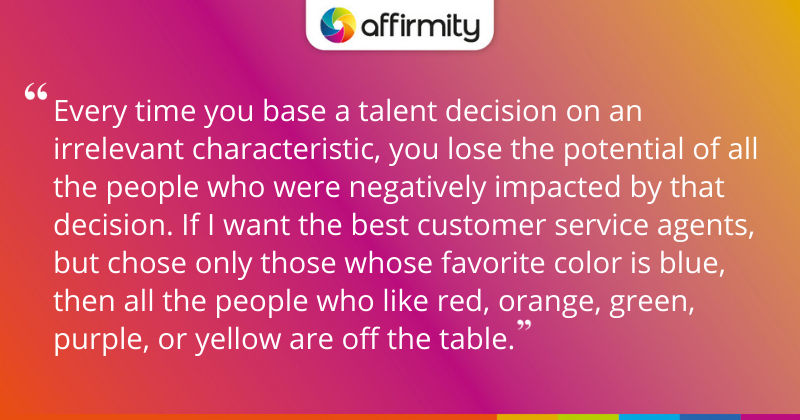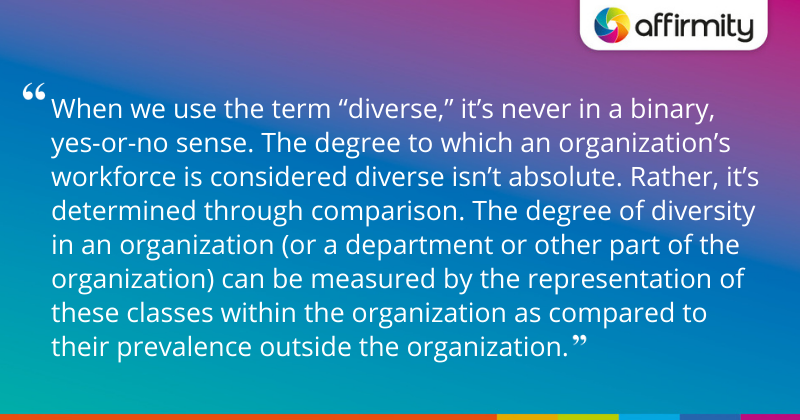Struggling to understand—let alone increase—diversity? In this article, Affirmity’s Patrick McNiel, PhD, an expert in workforce analytics and diversity insights, explains what workforce diversity is and defines 4 best practices HR leaders and recruiters can follow to make it a reality.
Scan any business journal, HR industry trade magazine, or leadership blog and you’ll find an article (or six) on the benefits of having a diverse workforce.
Customer satisfaction, productivity and innovation, employee retention, reputation—these and other critical business goals all correlate with greater diversity in the workplace.
The causal effects are not yet clear, but greater diversity is also related to elevated organizational performance. McKinsey’s well-known report, Delivering through Diversity, found that organizations whose executive leadership teams were more diverse by gender, ethnicity, and culture significantly outperformed their competitors.
So what’s going on here? Is there something inherent in greater diversity that improves outcomes?
Perhaps a hint can be found by defining what diversity actually is.

What Does it Mean to Have a Diverse Workforce?
In a broad sense, diversity is the degree to which people in some meaningfully defined group differ from one another on essentially all characteristics.
People may vary in height, attitudes about golf, ability to communicate, race, religion, general experience level, music preferences, marital status, the type of cars they drive, and an infinite number of other characteristics.
Obviously, not all variations are important. Some characteristics matter to the group because those characteristics affect the way the group functions or its ability to achieve a given goal. Other characteristics, in contrast, don’t matter at all.
In light of that, a more useful definition of diversity is the degree of differentiation between people on important characteristics.
For example, a product development team may need people who are good at thinking creatively AND people who are good at thinking analytically. Or a team that does market research may benefit from having a cross-section of people who are in touch with different segments of the company’s target market.
This kind of diversity creates a confluence of knowledge, skills, abilities, attitudes, motivations, perspectives, and traits to drive organizational success.
Smart companies always strive for this type of diversity. It’s common sense team-building.
But before your organization can leverage a confluence of diverse traits that are relevant to business success, you must first establish the foundations of diversity into your workforce.
TOOLS AND APPROACHES TO IMPROVE WORKFORCE DIVERSITY | ‘4 Ways to Build a Diverse Organization‘

Creating Diversity through Smart Talent Decisions
An organization is far more likely to achieve greater and more desirable diversity on important characteristics if talent decisions (hires, promotions, layoffs, training, etc.) are made using only important characteristics. That is, decisions must deliberately and explicitly not be based on irrelevant characteristics.
The reason for this is simple. Every time you base a talent decision on an irrelevant characteristic, you lose the potential of all the people who were negatively impacted by that decision.
For example, if I want the best customer service agents, but chose only those whose favorite color is blue, then all the people who like red, orange, green, purple, or yellow are off the table. If the best customer service agents are distributed evenly among the colors, I’ve limited my choices to a group with only a sixth of the best agents.
This brings us to diversity as defined by regulations—the definition typically associated with business outcomes.
MIRED IN MYTHS ABOUT D&I? | ‘Get 5 Truths about Diversity in the Workplace.’

How Do Employment Laws and Regulations Define Diversity?
The HR-specific meaning of diversity represents the more common understanding and usage when we talk about a diverse workforce.
The characteristics that create diversity as defined by regulations are called “classes,” and in almost all cases, these classes represent irrelevant characteristics:
- Gender
- Race/ethnicity
- Religion and national origin
- Age (specifically, those under 40 and those 40 and older)
- Individuals with disabilities
- Protected veterans.
This may seem straightforward enough, but in HR and workforce compliance, when we use the term “diverse,” it’s never in a binary, yes-or-no sense. The degree to which an organization’s workforce is considered diverse isn’t an absolute. Rather, it’s determined through comparison.
The degree of diversity in an organization (or a department or other part of the organization) can be measured by the representation of these classes within the organization as compared to their prevalence outside the organization.
This brings us to an important question: who is that outside population we’re using for comparison?
Until we define a comparator, any discussion about diversity at any level in an organization or in an industry is unclear.
MORE ON DEFINITIONS FROM THE BLOG | ‘What is Fair Pay? And What’s the Difference Between Equity and Equality?‘
Relevant Benchmarks: The Key to Driving Diversity
Generally, companies are most concerned with comparing segments of their organization with pools of available workers in specific job groups. (This applies in particular to federal contractors.)
So when looking at workforce diversity in an organization, typically we define our comparator as those who are qualified to do needed work.
But any organization or industry may experience pressure from its executive leadership, shareholders, or the public to foster diversity relevant to the general population. So it’s not always necessary—or helpful—to narrow down the population we’re using to assess organizational diversity.
In that case, we might define diversity in terms of its class make-up. That is, how similar is our organization compared to the class make-up of the general population within a specified geographic region.
Either way, the critical first step in measuring diversity is to define the question we’re seeking to answer. That question underpins the definition of diversity we use and ensures it’s appropriate to our purpose. And once the definition of diversity is established for that purpose, we can employ tools to help our organization become more diverse.
Ready to define the right benchmarks for your organization? See how diversity insights can drive better talent decisions.
 About the Author
About the Author
Patrick McNiel, PhD, is a principal business consultant for Affirmity. Dr. McNiel advises clients on issues related to workforce measurement and statistical analysis, diversity and inclusion, OFCCP and EEOC compliance, and pay equity. Dr. McNiel has over ten years of experience as a generalist in the field of Industrial and Organizational Psychology and has focused on employee selection and assessment for most of his career. He received his PhD in I-O Psychology from the Georgia Institute of Technology.
